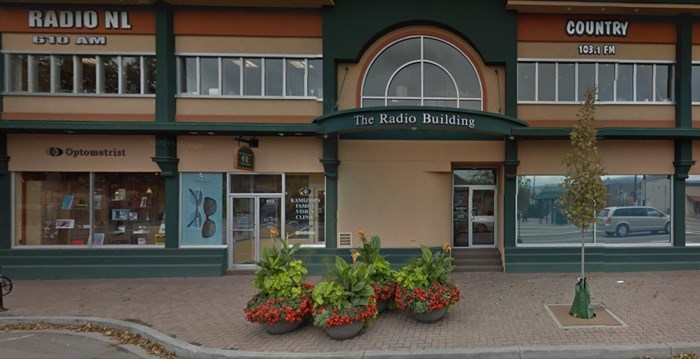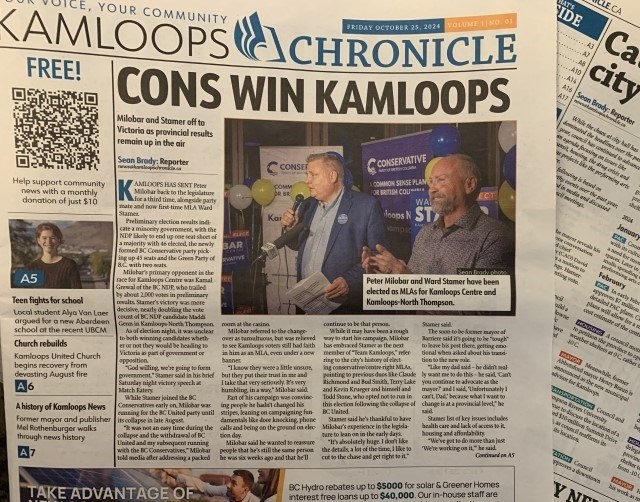
The NL Broadcasting centre in downtown Kamloops.
Image Credit: SUBMITTED/Google Maps
November 10, 2024 - 7:00 AM
Stop the presses.
It's a call alerting the printing room important, breaking news was coming or that a story needed to be changed before the upcoming edition was loaded onto trucks.
Now, if it means anything in most Canadian newsrooms, it might be that the print edition just closed, if not the outlet entirely.
Closures and layoffs have hit in Kamloops newsrooms in waves over the years, like many Canadian cities, but twice in just two years, the industry's decay confronted local news consumers.
First came last year's collapse of Kamloops This Week, then layoffs at Radio NL's newsroom in September as the station replaced most news broadcasts with music. (The Okanagan hasn't been without casualties either. The Kelowna Courier and Penticton Herald dropped to two editions per week and, earlier this year, a massive layoff at Global Okanagan reduced the regional TV station to a satellite now serving Global's Vancouver newscast.
They quickly brought drastic changes to the regional media landscape, but former journalist and Thompson Rivers University journalism instructor Alan Bass said there was "nothing sudden" about the closures and layoffs.
Bass started teaching in the university's journalism school in 1999 and twice served as its chair. He came to Kamloops after working nearly two decades in journalism, mostly for Ontario newspapers.
His time at the London Free Press was spent in a 160-person newsroom reporting for a city of 400,000 people. But readership was already on a steady decline in the 1990s, long before the effects of social media giants like Facebook were felt.
He said it took time to "trickle through the landscape," but "like a snowball, it grew and grew and grew."
"It was the internet that dealt the death blow," he said.
WHAT WAS LOST?
When Howie Reimer moved to Kamloops in the 1980s, 610 NL was a "powerhouse" in local and provincial news coverage.
He came from a Vancouver-based station. That might usually be considered a downgrade as smaller markets are often "stepping stones" in the media business, but not this time, he said. In this case, the Kamloops station was well respected across the province for its ability to break new stories.
"I found it quite intimidating seeing the level of expertise and how sound and credible the NL newsroom was," he said, noting its former employees like Angelo Lacobucci, Jim Harrison and Bob Price.
In his latter days, Reimer was NL's program director and the station had been bought out by larger companies twice before he left in 2021. Its office dwindled from 30 employees in Reimer's early days to just 10 before his departure. Three years later, it's left with two employees at the news desk, posting stories online.
"I got into radio because I loved radio and the connection you have to your audience and the community," Reimer said.
He said speaking with the community, either one-way to listeners or in conversations with callers and customers, gave him a connection with his Kamloops audience that is becoming more rare. Radio shows, he said, are becoming more regionalized with "evergreen, generic" content that has little, if any, relation to the local community. It's something that he said devalues the product.
In the years just before the most recent layoffs, locally-produced programming had dwindled to a morning show, an afternoon show and, through a partnership with the team, Kamloops Blazers coverage. The remaining airtime was filled with talk shows from larger centres.
Even with the cuts, their coverage of the 2021 Juniper wildfire that struck late in the evening on Canada Day gave up-to-date information for listeners as it spread quickly. No houses would be destroyed, but the radio team took calls early into the next morning to keep people informed in the way other media often cannot.
"I cringe to think what happens if we have a local emergency," he said. "Where are we going to get our live, up-to-the-minute information? It'll come down to Johnny posts a picture of the Red Bridge burning down, but we don't know why. There's no context, no story, we just see the bridge on fire."
The layoffs that cut his friends and former colleagues from the station left Reimer "heartbroken," but he felt similarly dismayed over Radio NL's legacy and how far it has fallen. Parent company Stingray owns radio stations across the country, but 610 NL was the only talk-based station in its roster.
"It boils down to the balance sheet. When you see the firing or the buyout of the experienced journalists and you try to bring in someone at minimum wage or slightly above," he said. "You're not going to get the same level of storytelling."
At their height, newspapers where Bass worked, like the London Free Press, were a one-stop shop for goings on in the region.
From hard news like courts and city hall, to weekly columns, sports coverage, and human interest stories, much of what filled the pages would come from a newsroom with beat reporters covering specific topics. Along with in-house reporting, they'd have obituaries, classifieds, upcoming events and comics, often delivered daily to a subscriber's door.
One of the biggest changes Bass highlights from over the years, one that might go less noticed by the average news consumer, is the drop in investigative stories, those that require travel or that simply need more time than the daily reporter could typically dedicate now.
Multi-day trips needed for a certain story, especially sports, or a week to investigate and write a story were not uncommon. Sometimes it was the more mundane tasks like spending a day simply meeting people who might become sources.
Bass said most outlets continue to focus on "(city) council, courts and cops," which he described as the "spine" of any newspaper. But many journalists have less time to dig beyond what's in the meetings or what's delivered by press relations teams, which are often made up of former reporters.
"An awful lot of what's happening, happens beneath the surface," he said. "If you're chasing news releases and events, if you're going to meetings but you don't have time to do anything more than that, an awful lot of news is going to get missed."
That's not to say it doesn't happen.
Some journalism in recent years, even locally, has the capacity to change government policies, uncover secrets or shape the news cycle for months or years to come. Reporting at Kamloops This Week shedding light on a Thompson Nicola Regional District spending scandal among its top brass is often cited as a prime example of investigative journalism. The months-long reporting effort followed the sudden but quiet departure of the regional district's top employee, leading to government policy changes and awards for the paper and journalist Jessica Wallace.
Two years later, the paper closed and staff moved on. Wallace moved on to the CBC and editor Christopher Foulds took a government communications job.
'EYEBALLS STARTED TO DRIFT'
As audiences turned not just online but to social media platforms, many news outlets came to rely on social media for distribution, especially Facebook.
Meta's ban on Canadian news content came after years of advertising revenue funneling into giant tech companies, where it might have traditionally gone to news outlets.
The federal government's effort to spread that money among news outlets required companies like Facebook and Google to pay for news links on their platforms. While Google has made some early efforts at a funding model, Meta banned Canadian news content to avoid paying at all.
The move slashed audience engagement at outlets across the country by nearly half, while three-quarters of Canadian news consumers weren't aware of the news ban at all, according to a study published in July.
While government's plan appeared to have backfired, it was just one in a series of impacts on the industry and they weren't always someone else's fault. Sometimes, they were self-inflicted, Bass said.
"When the internet came, newspaper managers honestly believed it was a passing fad, to the amazement of many of us in the industry," he said. "When I was a reporter, they wouldn't let us research online for a story."
Then in Ottawa covering federal politics, Bass couldn't use the internet for work, while readers were increasingly connecting their home computers to the world wide web.
"What happened? We had beginnings of things like Myspace, Yahoo, Google and then Netscape that made the internet more available to the average people," he said. "Eyeballs started to drift and, of course, so did advertising."

The Kamloops Chronicle published its first issue on Oct. 25, 2024.
(LEVI LANDRY / iNFOnews.ca)
Print and broadcast outlets previously competing for advertisers amongst each other slowly started to lose customers to internet platforms. Classified ads proliferated on websites like Kijiji and Craigslist, local events were increasingly posted online instead of papers. When subscriptions fell it meant not just a loss in a direct revenue source, but that fewer eyes on the pages paid for by advertisers.
Since 2008, 525 outlets have closed in Canada affecting 347 communities. A fifth of those were due to mergers, according to the Local News Research Project.
The internet made advertising cheaper, especially with the influx of social media platforms, but the blame hasn't been directed solely at the online ad market. Some point to the conglomeration of media companies like Black Press and Postmedia which simultaneously lowered overhead costs while eventually loading both with massive debts.
The conglomeration also led to market swaps like the TorStar and Postmedia deal in 2017 that saw 36 papers closed and shrunk competition in southern Ontario cities. The Competition Bureau investigated but ended with no charges.
"For a while, smaller community newspapers, like say Kamloops, were kind of shielded," Bass said. "Local advertisers and local citizens were slower to adapt to the internet, but eventually it happened."
Kamloops This Week had around 150 undelivered routes by the time it stopped printing last year. It was the last paper standing after the Kamloops Daily News stopped its presses in 2014. In the Okanagan, the Kelowna Courier and Penticton Herald keep going, with one editor serving both papers. The Courier, the city's longest running paper, would have had at least a dozen journalists 20 years ago and now is reduced to one reporter.

One of the iNFOnews.ca team's fleet.
(MARSHALL JONES / iNFOnews.ca)
'YOU'VE GOT TO PAY FOR IT'
The industry isn't dead, but after three decades of quickly-evolving technology it's still changing.
New outlets have risen in that time. Not all have survived with 128 out of 230 new publications since 2008 closing by this year.
Those 230 new local outlets have opened in 162 Canadian communities, with 123 based online and 79 as community papers.
One of those new outlets to open and stay is iNFOnews.ca, with reporters in Kamloops and the Okanagan. Some locals within that time closed and some have been swallowed up in mergers. Castanet took over the online publication Kamloops Matters, along with some older community newspapers like the Peachland View, Osoyoos Times and Oliver Chronicle. In turn, local ownership at Castanet would be bought up by Glacier Media, which boasts numerous titles in Western Canada.
The perceived demand for a community newspaper, however, continues to entice investment. In 2020, the Times Chronicle was formed in a simultaneous split from the Castanet umbrella and merger to serve Osoyoos and Oliver together. More recently, newspapers in Kamloops and in Peachland are launching just weeks apart from each other.
While many continue as private companies, funding models are beginning to change. It comes as news outlets continue to face the problem that it had from the beginning: journalists don't generate revenue. The Kamloops Chronicle printed its first issue last month as a non-profit. Following a failed effort to restart Kamloops This Week, former Kamloops city councillor Arjun Singh saw demand for a physical newspaper.
"Our ultimate goal is to potentially get back to a weekly," he said. "I think there's people who appreciate the tactile staying power of a publication."
He's serving as the executive director for a paper that doesn't yet have full-time newsroom staff, but it's looking for public donations in addition to advertising in order to stay afloat. It doesn't do door-to-door circulation, but it is free at locations throughout the city.
"It's been a really awesome experience that's bringing something back rather than taking it away," Singh said.
The switch to a non-profit model isn't widespread, but it is being adopted in Canadian media like The Tyee, which made the change two years ago. Some Canadian outlets remain private and are supported heavily by crowdsourcing, like the media criticism outlet Canadaland. Many rely on government subsidies to varying degrees, of which there are several federal programs for news outlets.
Bass said non-profits and philanthropic models have worked in some places as news companies evolve with the internet age, but he pointed to nationally-focused outlets like Pro Publica or the Jeff Bezos-backed Washington Post. Some outlets are returning to require subscriptions, whether simply for emailed newsletters like the Fraser Valley Current, or for payment like the Globe and Mail and Toronto Star. While it's not widespread among local outlets to require payment, most Canadians who do pay for news are subscribing to American outlets like the Washington Post or New York Times.
"We're going to have this new media universe where we're going to have a few national organizations. Local news, however, is the question right now," Bass said. "How are we going to ensure smaller, local communities — I'm including cities here, I'm not talking about hamlets — are going to be properly covered so their citizens actually know what's going on?"
He said news coverage, in his view, provides a public good for its readers, likening it to the public service a firefighter or police officer provides communities. He said at least part of the way toward sustainable local journalism is likely through public funding.
It's not just funding models changing but the medium too. In Kamloops, two journalistic projects take on different approaches without necessarily agreeing they fall under the definition of "journalism."
Nevin Webster, known locally for his Kamloops-centred meme creation, recently launched his podcast Loopszer delivering one-on-one interviews with local people. With a few episodes launched in quick succession, his first was with Mayor Reid Hamer-Jackson.
The other is local video production outlet Mastermind Studios, now in its tenth year since opening.
Peter Cameron-Inglis is hesitant to compare his work with local outlets like iNFOnews.ca, CFJC or Castanet. One local project Mastermind did take on is an interview series called Crisis Storm, which examined the mental health, homelessness and toxic drug crisis in Kamloops. Another was the satirical and controversial project "Cam El," which criticized the events at Kamloops city hall.
"I'm just a storyteller. I'm honoring people that helped to raise me by telling stories in the way they taught me to tell them", he said, although he did agree there is a journalistic mission in his work.
Much of their work is on documentaries, some feature length and some up to just 15 minutes. A recent project he worked on was centred around an Indigenous woman in Northern BC trying to raise funds for a care home in her local community while her sister is far away in a Southern Interior facility.
"So we did a short documentary on her and we're going to put it out there to shed a light on this injustice a little bit," he said. "Try to help people see something they've been turning a blind eye to.
To "pay the bills," Mastermind Studios helps produce commercials, works on film projects in the local area and offers video editing among its services.
Although newsrooms are getting smaller, there are still several outlets producing local journalism centred around your communities. There are several covering just Kamloops, as in the Okanagan, but the news industry continues to evolve and the Southern Interior is no exception.
To support local journalists at iNFOnews.ca, sign up for our email newsletter to get our stories delivered straight to your inbox.
To contact a reporter for this story, email Levi Landry or call 250-819-3723 or email the editor. You can also submit photos, videos or news tips to the newsroom and be entered to win a monthly prize draw.
We welcome your comments and opinions on our stories but play nice. We won't censor or delete comments unless they contain off-topic statements or links, unnecessary vulgarity, false facts, spam or obviously fake profiles. If you have any concerns about what you see in comments, email the editor in the link above. SUBSCRIBE to our awesome newsletter here.
News from © iNFOnews, 2024